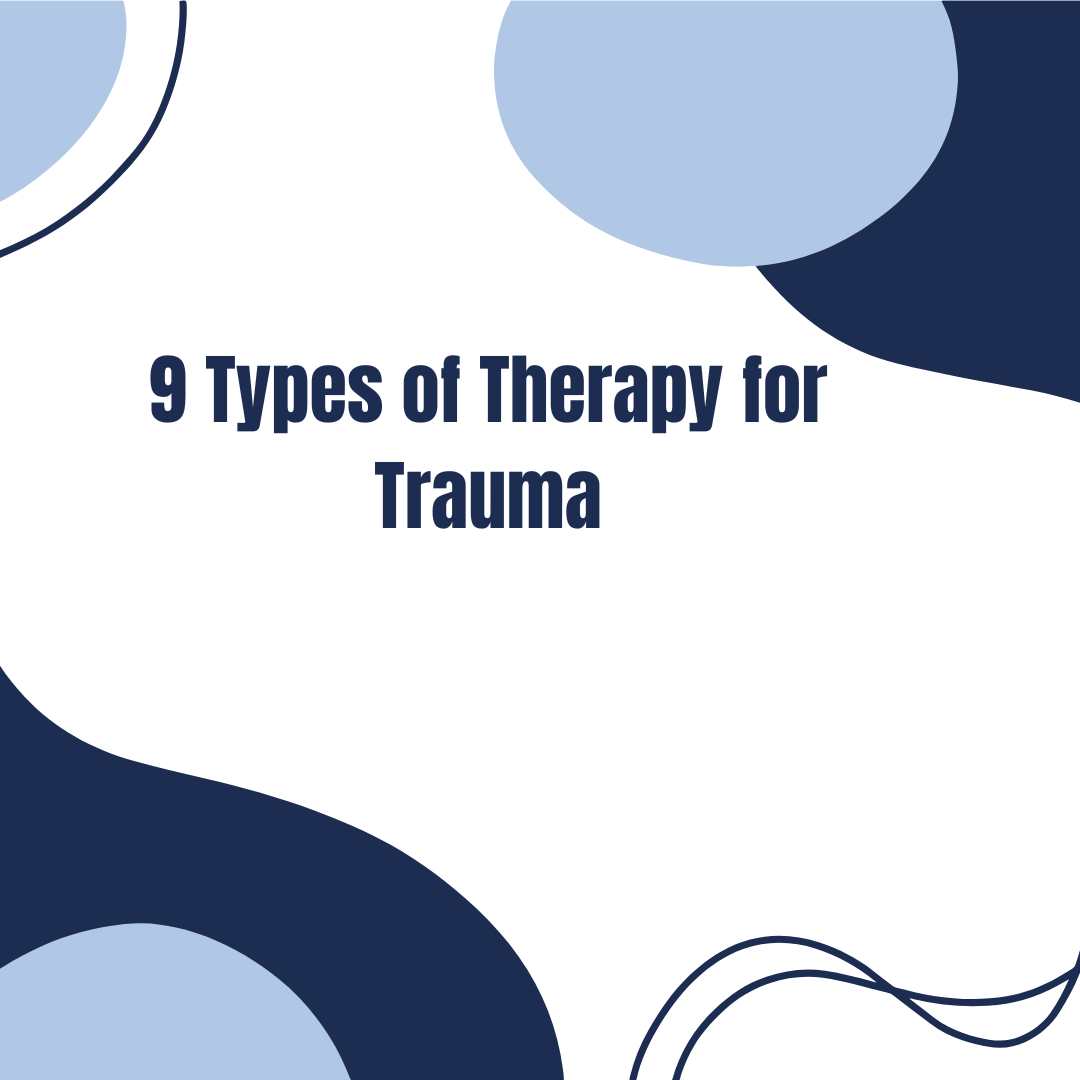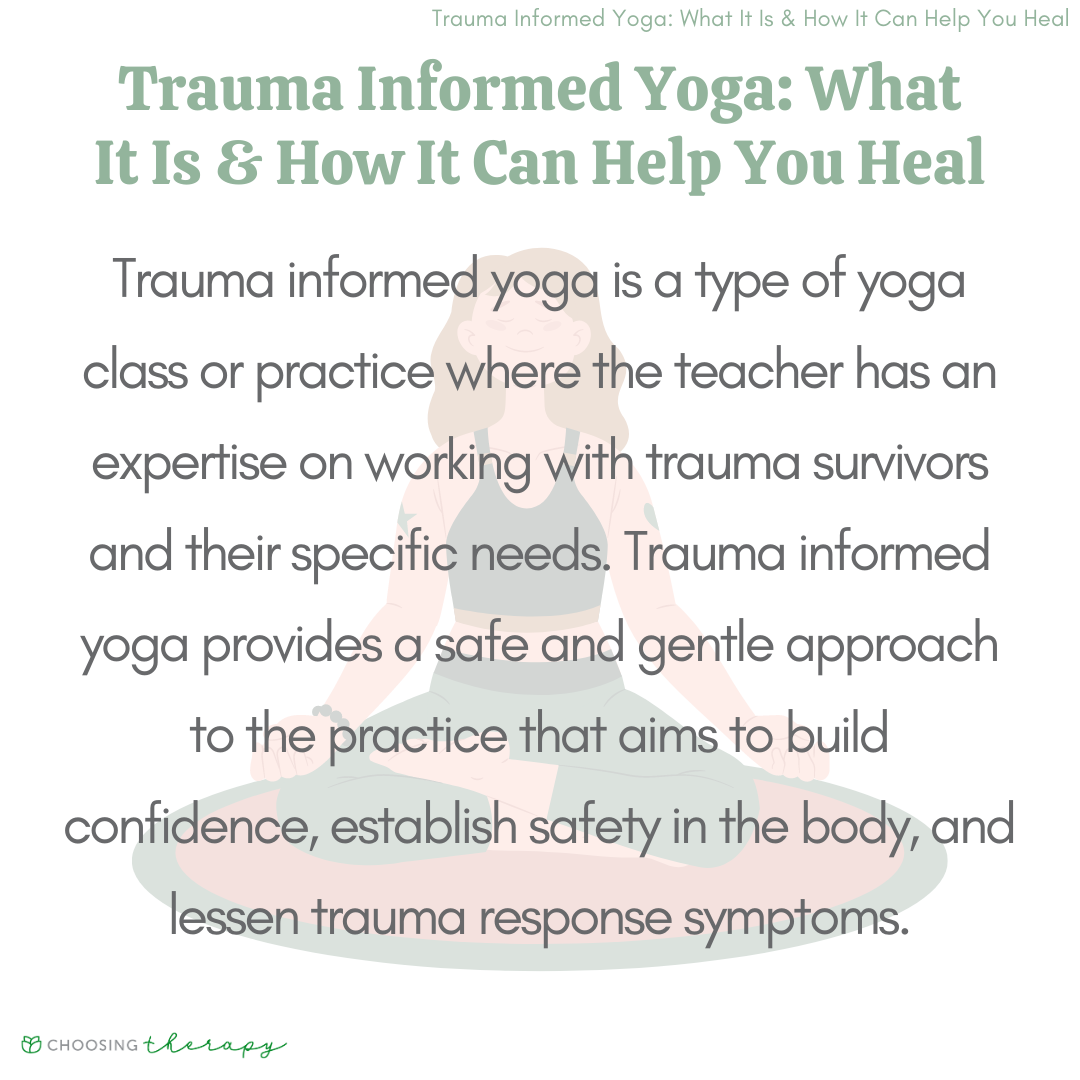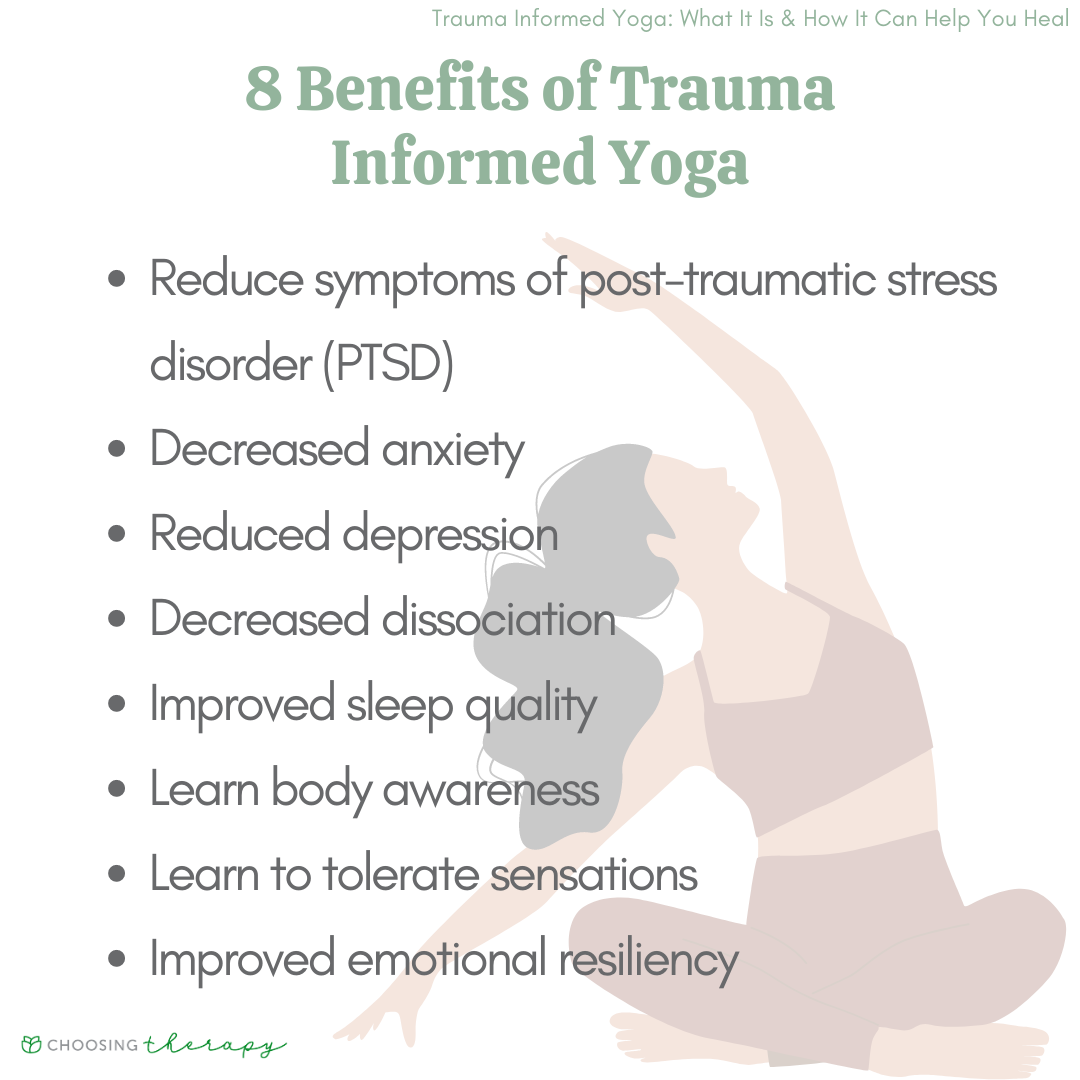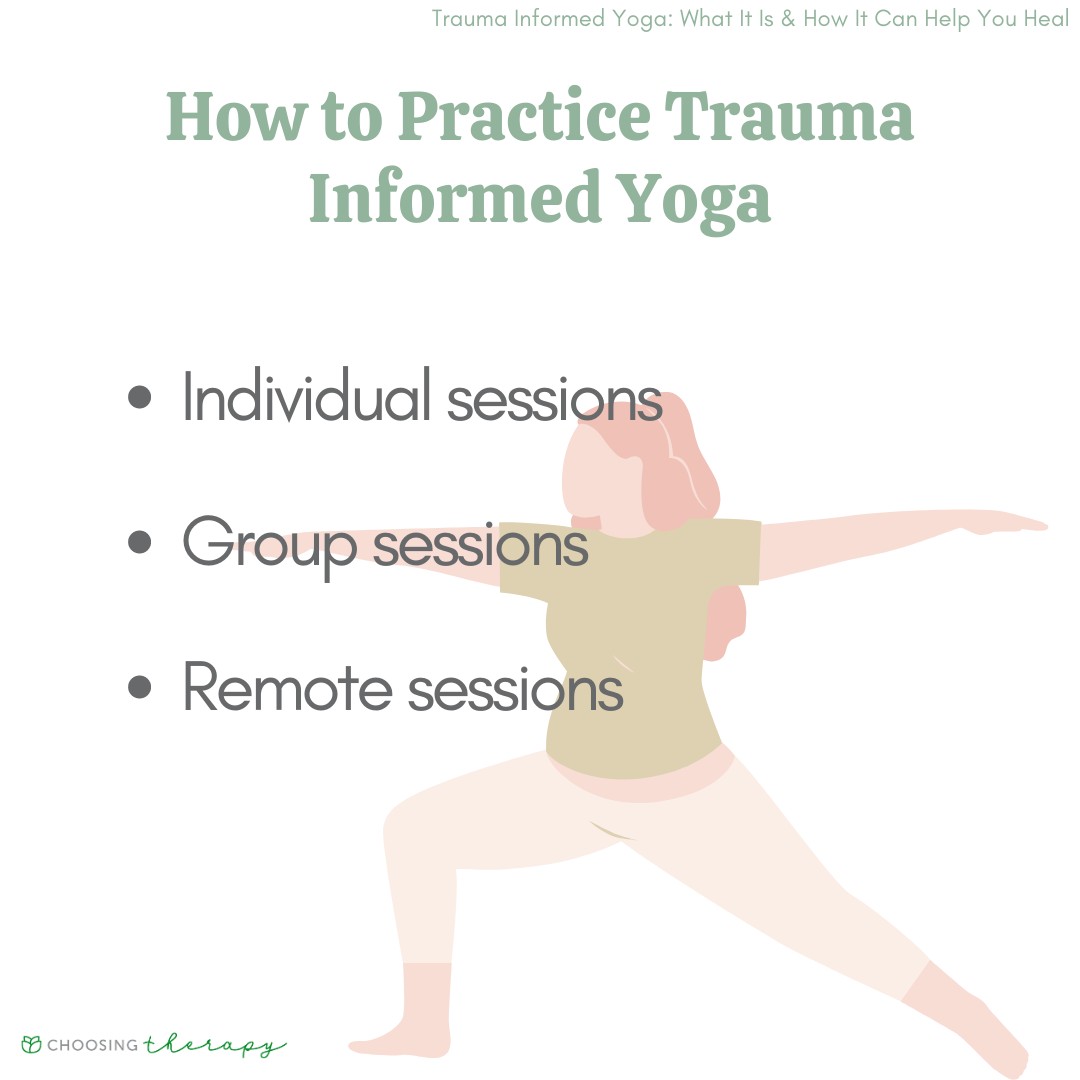
Trauma-informed yoga is a type of yoga class or practice where the teacher has expertise in working with trauma survivors and their specific needs. Trauma-informed yoga provides a safe and gentle approach to the practice that aims to build confidence, establish safety in the body, and lessen trauma response symptoms.
Recover From Trauma With The Help Of Therapist
Therapy can help you live a better life. BetterHelp provides convenient and affordable online therapy, starting at $65 per week. Take a Free Online Assessment and get matched with the right therapist for you!
What Is Trauma-Informed Yoga?
As emotions rise during the yoga experience, trauma-informed yoga encourages people to stay present, feel their feelings, and not dissociate from their body, which is a common trauma response. This approach helps to regulate one’s nervous system, particularly the fight or flight response.
What Is Trauma-Informed Teaching?
Trauma-informed yoga is a specialized training that educates teachers on how to approach students who are healing from post-traumatic stress disorder (PTSD) or complex PTSD. This is usually considered adjunct treatment to psychotherapy. Trauma-informed teaching is highly personalized through the sequence and pace of the session, so the teacher can address the unique needs of the individual.
How Is Trauma Informed Yoga Different from Traditional Yoga?
Trauma-informed yoga is different from traditional yoga in its specific attention to how the person experiences their body while doing the yoga practice. Trauma-informed yoga teachers are trained to understand the dissociative effects of trauma and work to slowly help the person integrate having new experiences, the yoga poses, while breathing, feeling, and being alert.
The trauma response is such that a person usually numbs or dissociates from their experience when thinking about the events of the trauma. That is why the trusting relationship of teacher and student is the bedrock of this practice. Once the student feels safe with the teacher, the student will be able to experiment with different poses, breath techniques, and slowing down to feel what is happening in the body, which is essentially working through the trauma response.
8 Benefits of Trauma-Informed Yoga
Research on PTSD reveals that traditional trauma treatment fails to address the complicated array of symptoms having to do with somatic complaints, loss of awareness of one’s present experience, and integration of the body and mind.1 Trauma-informed yoga provides the adjunct treatment for people who have somatic complaints associated with their trauma.
Benefits of trauma-informed yoga include:
1. Reduce Symptoms of PTSD
Trauma exists in the body, and trauma-informed yoga helps clients to release trauma from their body. This is accomplished by heightening their body awareness, learning to tolerate senses, and learning to breathe through it. PTSD symptoms slowly start to decrease as the body’s awareness and tolerance increases.2
2. Decreased Anxiety
Trauma-informed yoga helps address anxiety in clients as yoga moves the person into their parasympathetic nervous system, the rest and relax state of being. The more the person practices trauma-informed yoga, the more they start to access their parasympathetic nervous system, decreasing their anxiety.
3. Reduced Depression
Several studies have shown that yoga, as an adjunct treatment or primary intervention, helps to relieve symptoms of depression.3 Trauma-informed yoga is becoming more recognized as adjunct treatment for depression.
4. Decreased Dissociation
The aim of the trauma-informed yoga practice is to help the practitioner become aware of their body, sensations, and feelings and thoughts while learning to tolerate them. Becoming present helps reduce the pattern of dissociating.
5. Improved Sleep Quality
A national survey found that over 55% of people who did yoga found that it helped them get better sleep.4 Many of the breath exercises, or pranayamas, are calming and helpful in getting the body ready for sleep.
6. Learn Body Awareness
Yoga helps people gain an awareness of their body. Yoga postures call for the practitioner to fully participate, with their body, mind, and breath while holding the yoga posture.
7. Learn to Tolerate Sensations
PTSD research indicates that learning to regulate arousal is essential to recovery.1 Trauma-informed Yoga guides the practitioner to feel their body and senses, while in a safe and grounded environment. With consistent practice, the practitioner’s ability to tolerate senses will improve.
8. Improved Emotional Resiliency
As PTSD symptoms decrease in the body, emotional resiliency improves. Trauma-informed yoga stimulates the parasympathetic nervous system, the rest-and-relax function in the body, which moves people into a more relaxed state. This leads to people having more emotional resiliency as they learn the tools to manage daily stressors.
Help For Trauma / PTSD
Talk Therapy – Get help recovering from trauma from a licensed therapist. Betterhelp offers online therapy starting at $60 per week. Free Assessment
Online PTSD treatment – Talkiatry offers personalized care from psychiatrists who listen and take insurance. Get matched with a specialist in just 15 minutes. Take our assessment
What Research Says About Trauma-Informed Yoga
Multiple studies show that trauma-informed yoga shows to be effective for PTSD as an adjunct treatment,5 but most concluded that larger studies are needed. Presently, trauma-informed yoga seems to be the most effective as an adjunct treatment and not as the primary treatment for PTSD.
What Does Trauma-Informed Yoga Look Like?
Trauma-informed yoga can be taught individually or in a small group class. Trauma-informed yoga teachers have gone through additional training to understand trauma, PTSD, and the physiological symptoms of trauma.
Trauma-informed yoga instructors create a trusting relationship and a safe environment for the practitioner. The practice is less focused on the poses and has more of an emphasis on the practitioner embodying the poses and working through dissociation as it comes up during the class.6 The teachers pay attention to all details of the class such as language, touch, lighting, and most importantly, the state of the practitioner.
Common types of poses used in trauma-informed yoga include:
Tadasana/Mountain Pose
Tadasana is a seemingly basic pose but with full attention, it calls the practitioner into the present state of standing evenly on both legs, extending upward while stretching the arms fully downward and expanding the body from the center to the sides. The pose teaches balance, focus, concentration, and reveals to the practitioner all the internal movement of the body even when it is seemingly still.
Adho Mukha Svanasana/Downward Facing Dog Pose
Downward facing dog is both a standing pose and forward bend. This pose calls the practitioner to balance between the arms and legs with the focus of extending the legs backward and upward to extend the spine. A particular challenge in this pose, worth noting, is that while the arms and legs fully extend, the head releases downward to relax and release.
Adho Muka Virasana/Child’s Pose
Child’s Pose, or Adho Mukha Virasana, is a pose that is known to quiet the mind and pacify the nervous system. In this pose, the practitioner sits on their heels with their toes together and knees apart and bends forward with their arms extending. The practitioners allow their head to rest on the ground, which helps calm the mind.
Uttanasana/Forward Bend
Uttanasana is a standing forward bend where the legs are fully extended and the trunk releases over the legs. This pose teaches how to keep the legs active while the trunk and head release.
Vadrasana/Thunderbolt Pose
Vadrasana, or thunderbolt pose, is where the practitioner sits on their heels with their thighs and feet next to each other. The shoulders are over the hips. This is a wonderful pose that helps align the ankles, knees, and hips, while stretching them out.
Bharadvajasana/Spinal Twist
Bharadvajasana is a seated spinal twist. Twists bring flexibility in the spine. The practitioner learns to deepen the pose by moving and twisting with the breath.
Sarvangasana/Shoulder Stand
Sarvangasana or shoulder stand has numerous benefits including stimulating the endocrine, or hormonal system, allowing the organs to rest, strengthening the legs and lifting the spine. This pose has a particularly calming effect on the mind.
Savasana/Corpse Pose
Savasana, corpse pose, is the final resting pose at the end of a yoga sequence. It is an important pose as the practitioner learns to let go of their body completely. The pose serves to allow the body to rest, recharge, and transition from the yoga practice back to the day.
Recover From Trauma With The Help Of Therapist
Therapy can help you live a better life. BetterHelp provides convenient and affordable online therapy, starting at $65 per week. Take a Free Online Assessment and get matched with the right therapist for you!
How to Practice Trauma-Informed Yoga
You need to find a qualified trauma informed yoga instructor to begin the practice. The instructors are certified yoga teachers who have extra training in trauma treatment and applications for treatment in a yoga class. It is best to start in a class or individual sessions with a professional and then follow their guidance whether you should progress to start practicing on your own.
Ways to practice trauma-informed yoga include:
- Individual sessions: Individual sessions are great for people who are in acute trauma and would benefit from the individualized instruction. This may be best for someone who is new to yoga.
- Group sessions: Group sessions are an excellent way to begin trauma-informed yoga. Sessions will be more affordable than individual sessions.
- Remote sessions: Remote sessions are ideal for people who don’t have local access to trauma-informed yoga classes.
Risks of Practicing Trauma-Informed Yoga
The main risk of practicing trauma-informed yoga is to work with someone who is not qualified to teach the class. There is no national certification and little regulation for trauma-informed yoga. Instructors take additional training and you want to be sure to have a conversation with your instructor about their training and experience doing the work. You want to confirm that your teacher is equipped to handle psychological states of trauma and PTSD because feelings and emotions come up during trauma-informed yoga classes.
The other main risks are the physical risks which are minimal but to be considered when starting a physical practice. If you have injuries, medical conditions, or past or upcoming surgeries, tell your teacher before beginning the class and speak with your doctor prior to starting a new exercise routine.
Signs that you should pause your trauma-informed yoga practice include:
- Increased feeling of agitation after practice
- If your trauma feels triggered in the class
- If you end class constantly feeling depleted
- Physical discomfort or pain during the class
- Your trauma or PTSD doesn’t seem to improve after many months
- You haven’t built trust over time with your teacher
The Multi-Pronged Approach to Trauma
The multi-tiered approach to trauma is essentially combining medication, therapy, and complementary therapies as treatment for trauma. There is no right way to start the multi-pronged approach, but frontline treatment is usually psychotherapy as it is a foundation of treatment.7
Medication and complementary therapies can be added into someone’s treatment if a professional who is seeing the client feels it would be useful. It can be useful if symptoms are intense, consistent, and interrupting daily functioning.
It is important for consumers to be informed of trauma-informed yoga as a complementary treatment so they can seek this adjunct treatment if appropriate. Not all clinicians are familiar with trauma-informed yoga and its benefits, so clinicians may not bring it up as an option simply because they are unfamiliar.
Therapies that are often used in combination with trauma-informed yoga include:
- Eye movement desensitization and reprocessing therapy (EMDR): EMDR is a fairly untraditional type of therapy that utilizes the person’s rhythm of eye movements or tapping while recalling events related to the trauma. It is short term and effective work.
- Trauma-focused cognitive behavioral therapy (TF-CBT): TF-CBT is an approach to trauma treatment by working with the thoughts and behaviors associated with the trauma.
- Gestalt: Gestalt therapy is an approach with a focus on awareness, the therapeutic relationships, and the here-and-now present.
- Internal Family Systems: IFS is an approach to therapy that identifies multiple parts of one’s psyche and looks at the strengths of each part. IFS has been known for trauma treatment.
- Psychodynamic psychotherapy: Psychodynamic psychotherapy focuses on unconscious processes that affect a client’s behavior.
How to Find Professional Support
If you are beginning your trauma treatment, you may want to begin by finding a therapist. Once you are involved with in-person or online therapy treatment, finding a trauma-informed yoga teacher is an excellent adjunct treatment. If you are already acquainted with a yoga studio, you can inquire about a trauma-informed yoga teacher. You can also find a teacher through online searches. As you progress with your treatment, it is best to continue to check in with your therapist to gauge whether your treatment is helpful.
In My Experience
Trauma-informed yoga is an excellent adjunct treatment for people in trauma treatment. As a therapist and an Iyengar yoga teacher, I have found that bringing in yoga for trauma treatment has been effective in helping people move into their parasympathetic nervous system and out of the fight-or-flight state. I have seen people slowly start to relax their body where they could not let go while doing therapeutic yoga.
A trusting therapeutic relationship is vital for trauma-informed yoga. I have only brought in yoga for treatment when there is a trust in the relationship. Once the trust is established, trauma therapy and trauma-informed yoga can be effective in working holistically with people for trauma treatment.
Additional Resources
To help our readers take the next step in their mental health journey, Choosing Therapy has partnered with leaders in mental health and wellness. Choosing Therapy is compensated for marketing by the companies included below.
Online Therapy
BetterHelp – Get support and guidance from a licensed therapist. BetterHelp has over 25,000 therapists who provide convenient and affordable online therapy. Take A Free Online Assessment and get matched with the right therapist for you. Free Assessment
Online PTSD treatment
Talkiatry offers personalized care from psychiatrists who listen and take insurance. Get matched with a specialist in just 15 minutes. Take our assessment.
Treatment For Trauma & OCD
Half of people diagnosed with OCD have experienced a traumatic life event. The chronic exposure to stressful situations, such as ongoing bullying, or an abusive relationship can lead to the development of OCD symptoms. NOCD therapists specialize in treating both trauma and OCD and are in-network with many insurance plans. Visit NOCD
Trauma & Abuse Newsletter
A free newsletter for those impacted by trauma or abuse. Get encouragement, helpful tips, and the latest information. Sign Up
Choosing Therapy Directory
You can search for therapists by specialty, experience, insurance, or price, and location. Find a therapist today.
How Does ERP Help With Intrusive Thoughts? Obsessive compulsive disorder (OCD) is a psychiatric condition marked by the presence of obsessive thoughts, images, doubts, or urges, followed by compulsive behaviors or acts aimed at easing the distress caused by the obsession. While the content of the obsessions can take many forms, they are always repetitive, persistent, involuntary, and intrusive, and they often result in a great deal of anxiety for the person experiencing them. 9 Types of Therapy for Trauma Experiencing trauma can result in distressing and debilitating symptoms, but remind yourself that there is hope for healing. If you or a loved one is suffering from the aftereffects of trauma, consider seeking therapy. Trauma therapy can help you reclaim your life and a positive sense of self. 











